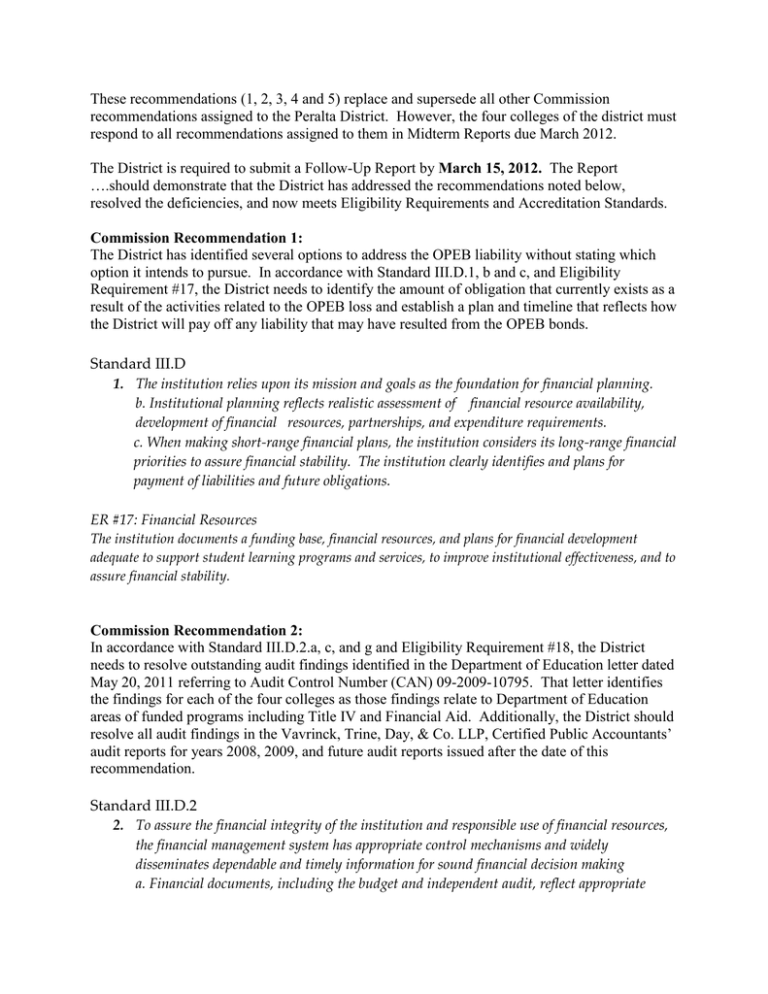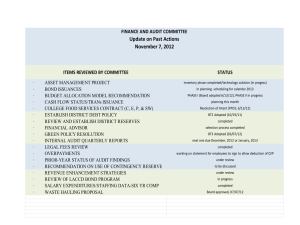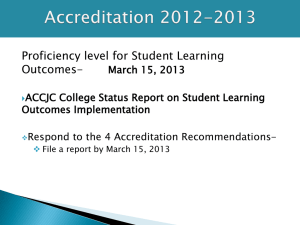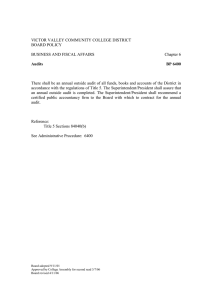ACCJC Recommendations as of 6-30-11
advertisement

These recommendations (1, 2, 3, 4 and 5) replace and supersede all other Commission recommendations assigned to the Peralta District. However, the four colleges of the district must respond to all recommendations assigned to them in Midterm Reports due March 2012. The District is required to submit a Follow-Up Report by March 15, 2012. The Report ….should demonstrate that the District has addressed the recommendations noted below, resolved the deficiencies, and now meets Eligibility Requirements and Accreditation Standards. Commission Recommendation 1: The District has identified several options to address the OPEB liability without stating which option it intends to pursue. In accordance with Standard III.D.1, b and c, and Eligibility Requirement #17, the District needs to identify the amount of obligation that currently exists as a result of the activities related to the OPEB loss and establish a plan and timeline that reflects how the District will pay off any liability that may have resulted from the OPEB bonds. Standard III.D 1. The institution relies upon its mission and goals as the foundation for financial planning. b. Institutional planning reflects realistic assessment of financial resource availability, development of financial resources, partnerships, and expenditure requirements. c. When making short-range financial plans, the institution considers its long-range financial priorities to assure financial stability. The institution clearly identifies and plans for payment of liabilities and future obligations. ER #17: Financial Resources The institution documents a funding base, financial resources, and plans for financial development adequate to support student learning programs and services, to improve institutional effectiveness, and to assure financial stability. Commission Recommendation 2: In accordance with Standard III.D.2.a, c, and g and Eligibility Requirement #18, the District needs to resolve outstanding audit findings identified in the Department of Education letter dated May 20, 2011 referring to Audit Control Number (CAN) 09-2009-10795. That letter identifies the findings for each of the four colleges as those findings relate to Department of Education areas of funded programs including Title IV and Financial Aid. Additionally, the District should resolve all audit findings in the Vavrinck, Trine, Day, & Co. LLP, Certified Public Accountants’ audit reports for years 2008, 2009, and future audit reports issued after the date of this recommendation. Standard III.D.2 2. To assure the financial integrity of the institution and responsible use of financial resources, the financial management system has appropriate control mechanisms and widely disseminates dependable and timely information for sound financial decision making a. Financial documents, including the budget and independent audit, reflect appropriate allocation and use of financial resources to support student learning programs and services. Institutional responses to external audit findings are comprehensive, timely, and communicated appropriately. c. The institution has sufficient cash flow and reserves to maintain stability, strategies for appropriate risk management, and realistic plans to meet financial emergencies and unforeseen occurrences. g. The institution regularly evaluates its financial management processes, and the results of the evaluation are used to improve financial management systems. ER #18: Financial Accountability The institution annually undergoes and makes available an external financial audit by a certified public accountant or an audit by an appropriate public agency. The institution shall submit with its eligibility application a copy of the budget and institutional financial audits and management letters prepared by an outside certified public accountant or by an appropriate public agency, who has no other relationship to the institution, for its two most recent fiscal years, including the fiscal year ending immediately prior to the date of the submission of the application. The audits must be certified and any exceptions explained. It is recommended that the auditor employ as a guide Audits of Colleges and Universities, published by the American Institute of Certified Public Accountants. An applicant institution must not show an annual or cumulative operating deficit at any time during the eligibility application process. Commission Recommendation 3: While evidence identifies progress, the District has not achieved compliance with Standard III.D and Eligibility Requirement #17. Specifically, the District has not achieved a long-term fiscal stability related to resolution of collective bargaining agreements on compensation and postretirement benefits. Therefore, in order to meet the Standards and the Eligibility Requirements, the District must assess its fiscal capacity and stability and implement actions to resolve the deficiencies. Standard III.D Financial resources are sufficient to support student learning programs and services and to improve institutional effectiveness. The distribution of resources supports the development, maintenance, and enhancement of programs and services. The institution plans and manages its financial affairs with integrity and in a manner that ensures financial stability. The level of financial resources provides a reasonable expectation of both short-term and long-term financial solvency. Financial resources planning is integrated with institutional planning. (Subsections not included) ER #17: Financial Resources The institution documents a funding base, financial resources, and plans for financial development adequate to support student learning programs and services, to improve institutional effectiveness, and to assure financial stability. Commission Recommendation 4: While evidence identifies progress, the District has not achieved compliance with Standard IV.B and Eligibility Requirement #3. Specifically, the District has not completed the evaluation of Board policies to the end of maintaining policies that are appropriate to policy governance and excluding policies that inappropriately reflect administrative operations. Therefore, in order to meet Standards and Eligibility Requirements, the District must evaluate all Board policies and implement actions to resolve deficiencies. Standard IV.B In addition to the leadership of individuals and constituencies, institutions recognize the designated responsibilities of the governing board for setting policies and of the chief administrator for the effective operation of the institution. Multi-college districts/systems clearly define the organizational roles of the district/system and the colleges. (Subsections not included) ER #3: Governing Board The institution has a functioning governing board responsible for the quality, integrity, and financial stability of the institution and for ensuring that the institution's mission is being carried out. This board is ultimately responsible for ensuring that the financial resources of the institution are used to provide a sound educational program. Its membership is sufficient in size and composition to fulfill all board responsibilities. The governing board is an independent policy-making body capable of reflecting constituent and public interest in board activities and decisions. A majority of the board members have no employment, family, ownership, or other personal financial interest in the institution. The board adheres to a conflict of interest policy that assures that those interests are disclosed and that they do not interfere with the impartiality of governing body members or outweigh the greater duty to secure and ensure the academic and fiscal integrity of the institution. Commission Recommendation 5: While evidence identifies progress, the District/Colleges have not achieved compliance with Standard III.D and Eligibility Requirements #5 and #17. Specifically the District/Colleges do not demonstrate the fiscal capacity to adequately support quality student learning programs and services. Therefore, in order to meet Standards and Eligibility Requirements, the District/Colleges must evaluate the impact of financial decisions on the educational quality and implement actions to resolve any deficiencies. Standard III.D Financial resources are sufficient to support student learning programs and services and to improve institutional effectiveness. The distribution of resources supports the development, maintenance, and enhancement of programs and services. The institution plans and manages its financial affairs with integrity and in a manner that ensures financial stability. The level of financial resources provides a reasonable expectation of both short-term and long-term financial solvency. Financial resources planning is integrated with institutional planning. (Subsections not included) ER #5: Administrative Capacity The institution has sufficient staff, with appropriate preparation and experience to provide the administrative services necessary to support its mission and purpose. ER #17: Financial Resources The institution documents a funding base, financial resources, and plans for financial development adequate to support student learning programs and services, to improve institutional effectiveness, and to assure financial stability.



